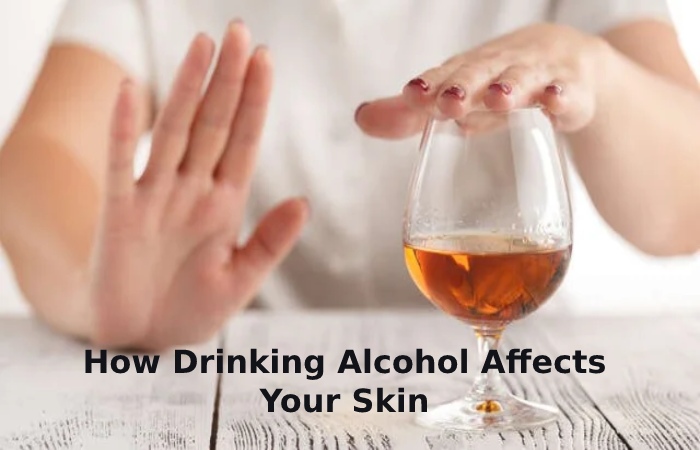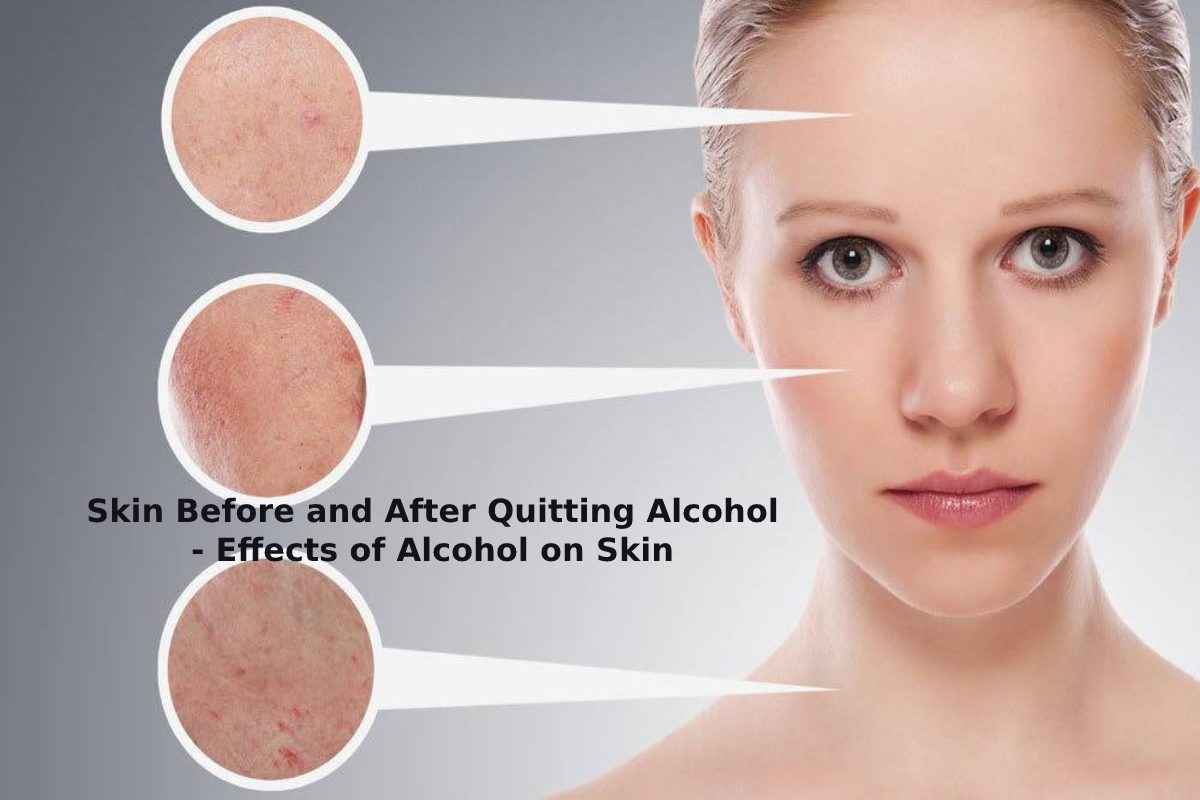Table of Contents
How Skin Before and After Quitting Alcohol
Skin Before and After Quitting Alcohol, AS fun as alcohol is, it can be bad for your health, especially if you drink too much. Your margarita Mondays and thirsty Thursdays may seem fun, but one too many drinks can harm your health and, in this case, your skin.
While many of us pay attention to the negative effects of alcohol on the liver, we tend to forget about its effects on the largest organ in your body: your skin. INSIDER spoke to some skincare experts to learn about the main effects alcohol has on the skin and what occurs to your complexion when you leave it out.
You’re Skin Before and After Quitting Alcohol
- Frequent and excessive consumption of alcohol causes dehydration, inflammation, and premature aging.
- It also aggravates existing skin conditions and increases the risk of developing new skin problems.
- By stopping drinking, you can reverse many harmful effects alcohol has on your skin.
- While an occasional glass of wine shouldn’t cause skin health problems, frequent heavy drinking can. However, quitting alcohol can positively change your skin’s health if you’re a heavy drinker. Photos of people’s skin before and after they quit alcohol show that much of the damage caused by drinking can be reversed over time.
How Drinking Alcohol Affects Your Skin

Alcohol has been shown to negatively affect the skin in several ways, producing unwanted short-term side effects that can develop into more problematic concerns over time.
Dehydration
Alcohol is a diuretic, which means that it promotes the removal of fluids from the body. Therefore, consuming alcohol without staying hydrated (for example, drinking a glass of water between alcoholic drinks) will cause your body to become dehydrated. Signs of dehydration include dark circles under the eyes, puffiness, and dry skin.
Flushing
A common side effect of drinking alcohol is flushing or flushing. It is often associated with red wine, which contains tannins and histamines that cause a reaction in some people.
For many persons of East Asian descent, alcoholic beverages cause noticeable flushing of the face, neck, shoulders, and occasionally the entire body. This effect is due to a genetic condition that disrupts the metabolism of alcohol.
More importantly, this redness is a concern, as it is associated with an increased risk of esophageal squamous cell carcinoma due to alcohol consumption.
Tired Look
Although alcohol may help you sleep well in the first half of the night, it makes sleep worse in the second half. As a result, you’ll likely see changes to your skin associated with insufficient rest, including dark circles, red or puffy eyes, fine lines and wrinkles, and a sagging mouth.
Long-Term Effects of Alcohol on the Skin
Current US Department of Agriculture dietary guidelines suggest that consumption should be no extra than one alcoholic drink per daytime for women and two for men. More consumption has a long-term negative effect on the skin.
Excessive alcohol consumption (four drinks for women or five for men in two hours) is even more harmful than having the same number spread throughout the week.
If you are a hefty drinker, your alcohol consumption will soon affect the health of your skin. Excessive alcohol consumption accelerates the aging process of the skin and reduces the overall health of the skin.
Acne
Although alcohol does not directly cause acne, many of its effects increase the risk of developing it. For example, dehydration caused by chronic alcohol consumption can cause the skin to produce excess sebum, the skin’s natural oil. In addition, the inflammatory effects of alcohol affect the immune response, increasing susceptibility to bacterial infections.
The higher oil content and the inability to fight acne-causing bacteria can lead to more frequent breakouts.
Large Pores
Excess sebum and reduced elasticity can increase the visibility of pores. While meaningless, larger pores make your skin look older and less healthy overall.
Damage of the Elasticity
Chronic alcohol practice limits the skin’s ability to repair itself and depletes collagen and elastin, two key proteins that give skin strength and elasticity. Lower levels make your skin more prone to sagging and wrinkles, which ages your appearance.
Psoriasis
Alcohol abuse has been linked to psoriasis, a disease that causes patches of skin that are itchy, dry, and scaly. The patches may appear as a rash or as red or silvery plaques.
A study of American women that examined the association between the type of alcohol consumption and psoriasis found an increased risk for women who consumed 2.3 drinks per week or more compared to non-drinkers.
Non-light beer has been linked to an increased risk of developing this skin condition; Light beer, red and white wine, and spirits were not.
Rosacea
Rosacea is a chronic skin illness that causes redness, bumps, and tenderness on the face. Alcohol consumption is both exacerbation and a risk factor for this condition. A long-term study of more than 82,000 women found that alcohol use was significantly associated with an increased risk of rosacea.
Skin Cancer
Alcohol is associated with an enlarged risk of cutaneous basal cell carcinoma and squamous cell carcinoma, the latter related to white wine consumption.
Spider Veins
Ethanol’s, a side-effect of alcohol metabolism, have been reported to dilate, or dilate, blood vessels. With chronic alcohol use, these blood vessels permanently dilate, resulting in visible spider veins.
Susceptibility to Damage
When it breaks down, alcohol releases free radicals into the blood. To combat them, your body uses antioxidants like vitamin A, which lowers your overall levels of these antioxidants.
Without strong levels of antioxidants, your skin is more susceptible to disease and infection. They are also at enlarged risk of sunburn, which is linked to the negative things of photoaging, such as bad sun skin, wrinkles, and sagging skin.
Alcohol Damage to the Skin can be Overturned?
The short-term things of alcohol on the skin wear off fairly quickly. The average person absorbs alcohol at the rate of one drink per hour. Once all the alcohol is removed from your system, you will no longer be dehydrated, you will rest well, and short-term symptoms such as dark circles under your eyes will disappear.
If you stop drinking altogether, conditions made worse by frequent alcohol use are likely to improve. For example, if you have rosacea, stop having flare-ups from drinking. While no studies have straight linked alcohol cessation to reduced psoriasis symptoms, anecdotal evidence suggests that it leads to improvement.
However, some effects of chronic heavy alcohol use on the skin may not go away soon; For example, deep lines and wrinkles affected by chronic dehydration may soften but are likely to remain.
Skin Improvements After Quitting Alcohol
When you stop drinking alcohol, you will see many improvements in your skin immediately and over time. You’ll also enjoy several other health benefits, including reduced risk of disease, lower blood pressure, better organ function, weight loss, and improved mental health.
Light and Even Skin Tone
The red, mottled skin associated with drinking will disappear, leaving a more radiant complexion. In addition, enlarged pores can tighten and improve skin texture.
Fewer Wrinkles
Well-hydrated skin means a reduction in the presence of fine lines and wrinkles. Your skin is better equipped to fight free radicals, which delays the formation of new wrinkles.
Hydrated and Smoother Skin
Once your skin rids itself of the dehydrating effects of alcohol, your skin’s water, and sodium levels will return to normal. As a result, your skin will seem smoother and fuller without the unhealthy puffiness often associated with excessive alcohol consumption.
Reduced Inflammation
Without the chronic inflammation in your system caused by alcohol, your skin has a better immune response. As a result, if you have rosacea, you will experience fewer flare-ups. In addition, inflammatory diseases such as plaque psoriasis and acne may become less severe or disappear altogether.
How Long After Quitting Alcohol Does Skin Improve?
When you stop drinking alcohol, you will see improvements almost immediately.
After 1-2 weeks, skin conditions associated with dehydration begin to recover. Fine lines and pores are less noticeable, and your skin appears smoother and healthier.
After about one month of no-alcohol breaks, acne and inflammatory skin conditions like rosacea (as long as they’re not triggered by factors other than alcohol) go away.
Six months to 1 year after you stop drinking, your skin will have fully recovered. The exception is cases of liver damage; Skin conditions caused by a damaged liver can be permanent.
Conclusion
Along with its other health benefits, abstaining from alcohol has numerous benefits for your skin. Alcohol dehydrates and inflames the skin, causing premature aging. Chronic abuse can lead to conditions like rosacea, psoriasis, and acne, as well as more serious health problems like skin cancer.
By stopping alcohol consumption, you can alleviate or completely cure the symptoms of these diseases. Over some days to 1 year, your skin will become more radiant, firmer, and healthier.
Also Read: Skin Nutrition – Complete Guide for Skin Nutrition More in 2022

